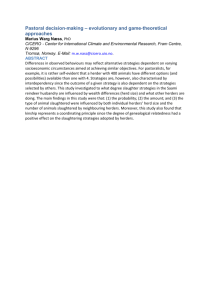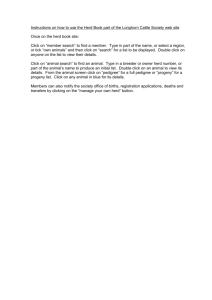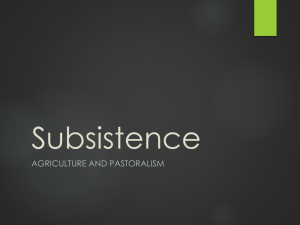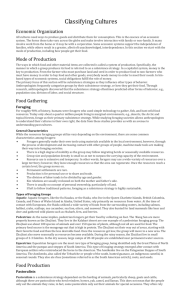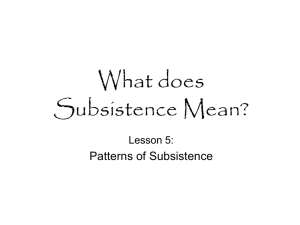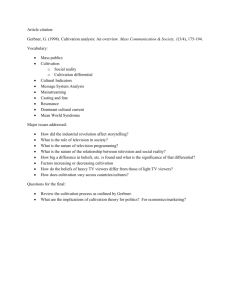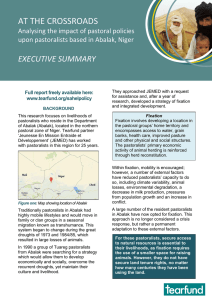Subsistence Strategies
advertisement
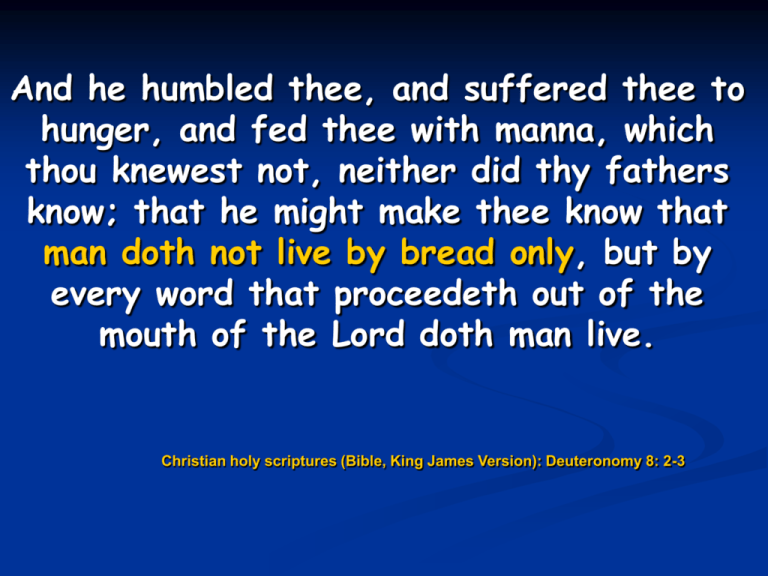
And he humbled thee, and suffered thee to hunger, and fed thee with manna, which thou knewest not, neither did thy fathers know; that he might make thee know that man doth not live by bread only, but by every word that proceedeth out of the mouth of the Lord doth man live. Christian holy scriptures (Bible, King James Version): Deuteronomy 8: 2-3 A FIFTH Subsistence Strategies Industrialization Subsistence Strategies Foraging (Gathering / Hunting) Horticulture Pastoralism Agriculture Foraging / Gathering-Hunting Basic mode of exploiting environment for 99% human history - found everywhere Nomadic / semi-nomadic / transhumance Wild plant & animal resources Recent times: relegated to marginal areas Intimate knowledge life-cycles of plants/animals Diet Nutritionally superior to traditional agriculturalist & modern industrial societies Foraging / Gathering-Hunting Socio-cultural characteristics Division of labor by sex & age Arose within last 50,000 - 100,000 years Usually limited material stuff Land / resources available to all group members Exceptions (Calif., Pacific NW): resource areas exploited by members of particular kinship group Foraging / Gathering-Hunting Socio-cultural characteristics Small group size Flexible group composition Bilaterial descent and kinship structure Sharing ethos Egalitarian Foraging / Gathering-Hunting Recent (last 150 years) Representatives • San (Ju/'hoansi): Botswana; S. Africa • Innu: Canada (also Siberia, Alaska, Greenland) • Paiute: Great Basin of N. America • Pygmies (e.g., Baka; Mbuti): Central Africa • Jarawa and Sentinelese: Andaman Islands • Pila Nguru (The Spinifex People): Great Victoria Desert, Western Australia Baka Pastoralism The care, tending, and use of domesticated animals (camels, llamas, cattle, reindeer, sheep, goats, yaks, etc.). Modern pastoralists found in every part of the world. Yoruk sheep herders, Turkey Sami reindeer herders, Norway Nuer cattle herders, Sudan Tuareg camel herders, Chad Pastoralism - Basic Features Reliance upon domesticated animal herds Diet Heavily dependent on milk, animals seldom eaten Natural pastures (no cultivation of fodder) Nomadic as well as Transhumance systems Main forms: cattle, sheep, goats (a few systems: camels, reindeer) Sometime herd more than one species Herds moved from pasture to pasture as they exhaust grasses or seasons change Animal resources sometimes supplemented by agriculture Complementary farming or trade with farming communities Pastoralism: Sociocultural Traits Population size: a few thousand to tens of thousands Small herd-management units (extended patrilocal households) Stock used for bride wealth payments / other social exchanges Parallel cousin marriage Wealth differences based on differential stock ownership Decentralized political organization Complex relationships with settled agricultural communities Trade/other exchange; sometimes political subjugation (e.g. modern States) Mongolian Pastoralists Mongolian Pastoralists The Basseri: Iranian Pastoralists Territory & Location Inhabit province of Fars Migrate along steppes and mountains near the town of Shiraz (transhumance) Clearly delineated group defined by political rather than ethnic or geographical criteria. Late 1950s: 16,000± Basseri Subsistence Sheep & goats: food, hides, wool Every family has a herd of about 100 animals Donkeys: pack animals; women, children sometime ride Horses: ridden by men, sometime by women Camels: beasts of burden Wealth Is In One’s Herd Wealth shown by amount of animals in one’s herd As herd grows, so does one’s wealth Horticulture (Extensive Cultivation) Farmers not make heavy labor commitments or expenditures to create capital items (e.g irrigation) Cultivation strategies designed to maximize use of unmodified natural resources Basic plot patterns designed to replicate rather than restructure natural environment; involve techniques of intercropping of complementary plants After short periods of cultivation: lengthy fallow periods imposed to re-establish soil fertility Yields per acre: relatively low Horticulture: Socio-cultural Traits Moderate population densitie (100 to 300/sq. mile) Sedentary: settle in (semi-) permanent villages) Localized unilineal descent groups that allocate land use and assume other corporate functions Intergroup integration through the development of pan-tribal sodalities, such as age grades Absence of Occupational specialization Wealth stratification Political centralization Cameroon Highlands Unmodified Rainforest Phase I Phase II Phase I Phase II Forest cleared, planted w/mix maize, cocoyam, raffia palm, coffee Some tree cover retained: protect crops & allow for forest regeneration After 3 years: annual food crops of maize & cocoyam have been harvested off Tree crops (plantain, raffia palm, coffee) remain, replacing traditional fallow regime of natural woodland succession Agriculture (Intensive Cultivation) Pre-Industrial Labor intensive Wide variety of systems recorded Concentrate human labor input on a given acre of farmland Most depend on irrigation, animal-drawn plowing, or both Main features Modification of natural environment to increase land productivity Creation of capital works and capital goods Use of fertilizers Monoculture Permanent cultivation of farm plots High yields per acre


